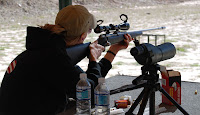They stood on their chairs. They cheered. They stood on table tops. They cheered. They hugged. They cheered. They rang cow bells. They cheered. They fired confetti bombs into the air. They cheered some more.
They give of their time, their talents, their money, and their energy. They number more than 10,000 strong across the United States. Who are they? They are volunteers for the
Rocky Mountain Elk Foundation! And they are indeed the heart and soul of an organization!
![]()
RMEF recently honored its volunteers at the most rowdy and spirited event at its annual Elk Camp national convention in Las Vegas dubbed, appropriately enough, Volunteer Fun Night. More than a thousand colorfully clad, energetic volunteers and members packed the Mirage to cheer for themselves and their counterparts from chapters across the country.
Below is a listing of chapter and individual volunteer accomplishments for 2012 celebrated at Elk Camp.
Top Fundraising States
1. Wyoming $1,659,708
2. Montana 1,520,412
3. California 1,519,533
4. Colorado 1,358,168
5. Washington 1,190,802
6. Oregon 1,062,012
Top Fundraising Chapters ![]() |
| Wyoming #1 State |
1. Tucson, Ariz. $412,970
2. Fresno, Calif. 357,785
3. Grand Junction, Colo. 308,826
4. Billings, Mont. 271,821
5. Gillette, Wyo. 227,180
6. Dime Box, Texas 214,286
Top Fundraising New Chapters
1. Etna, Wyo. $49,371
2. Fort Morgan, Colo. 28,666
3. Cedar Falls/Waterloo, Iowa 22,456
![]() |
| Tucson #1 Chapter |
Supporting Members
1. Salt Lake City, Utah 1,165
2. Grand Junction, Colo. 526
3. Denver, Colo. 500
Sponsor Members
1. Tucson, Ariz. 163
2. Grand Junction, Colo. 124
3. Poplar Bluff, Mo. 78
![]() |
| David Allen |
![]() |
New Chairman of the Board
Lee Swanson |
Life Members
1. Grand Junction, Colo. 60*
2. Tucson, Ariz. 22
3. Libby, Mont. 9
4. Salt Lake City, Utah 9
*all-time single year record
Major Gifts
1. Fresno, Calif. $250,000
2. Billings, Mo 153,000
3. Vansant, Va. 150,000
Big Game Banquet Net
1. Dime Box, Texas $173,050
2. Tucson, Ariz. 142,842
3. Midland, Texas 127,679
Big Game Banquet Net/Gross Specific Event Net
1. Jefferson City, Mo. 87% 1. Florence, Ky. $122,202
2. Dime Box, Texas 82 2. Tucson, Ariz. 65,012
3. Beaumont, Texas 80 3. Lander, Wyo. 58,022
New $3 Million Chapter (lifetime)
Grand Junction, Colo. $3,113,642
New $2 Million Chapters (lifetime)
Kalispell, Mont. $2,085,111
Houston, Texas 2,050,764
Salt Lake City, Utah 2,038,992
Albuquerque, N.M. 2,015,267
New $1 Million Chapters (lifetime)
Tillamook, Ore. $1,074,245
Bellevue, Wash. 1,073,174
Riverton, Wyo. 1,064,873
Dallas, Texas 1,057,987
Pinetop, Ariz. 1,047,057
Aberdeen, Md. 1,033,560
Jackson, Wyo. 1,030,058
Florence, Ky. 1,027,035
Reno, Nev. 1,017,116
Eugene, Ore. 1,009,646
Lander, Wyo. 1,008,601
Everett, Wash. 1,000,140
Olympia, Wash. 1,000,094
![]() |
Greg Harris & Outgoing
Chairman of the Board
John Caid |
2012 Chairman’s Award Recipients
Chairman Awards are given each year to recognize standout RMEF volunteers. Four recipients are chosen by their peers for their dedication to the Elk Foundation’s mission.
Idaho—Greg Harris, Moscow, Idaho, RMEF Palouse/Whitepine Chapter
A founding member of his chapter, Harris made a lifelong commitment to ensure today’s youths have the same hunting, fishing and outdoor opportunities he had. Harris helps with banquets, mentors new members and volunteers, and leads by example every day.
![]() |
| Steve Hopkins |
Arizona—Steve Hopkins, Tucson, Ariz., RMEF Tucson Chapter
As an RMEF life member, past state chair and Tucson Chapter committee volunteer for nearly two decades, Hopkins committed a great deal of time and energy to wildlife conservation. The Arizona Game and Fish Department and Tucson’s mayor honored him for his ongoing efforts.
![]() |
| Tim Jacobson |
Wisconsin—Tim Jacobson, Kenosha, Wis., RMEF Des Plaines River Chapter
Shortly after his first elk hunt in 1993 and a visit to RMEF headquarters in Montana, Jacobson founded the Des Plaines River Chapter. He turned the annual chapter banquets into a family affair. His passion and leadership led the chapter to raise more than $500,000 in just 15 years.
![]() |
| Taylor Orr |
Kentucky—Taylor Orr, London, Ky., RMEF Cumberland Valley Chapter
Orr’s service on the Kentucky Department of Fish and Wildlife Commission is one example of his great leadership and love for elk and elk country. He also travels around the state to attend banquets and generously gives of his time and money to advance RMEF’s mission.
RMEF volunteers work tirelessly to host big game banquets in their individual chapters. Funds from those gatherings are turned around and put back on the ground in their own states to further RMEF’s mission of enhancing the future of elk, other wildlife, their habitat and our hunting heritage. Volunteers also provide the backbone and muscle for a wide range of on-the-ground projects to benefit elk and elk country. Since 1984, RMEF volunteers helped to preserve or enhance more than 6.2 million acres of habitat, assisted in opening or securing nearly 645,000 acres for public access, and helped complete more than 8,000 permanent land protection, habitat stewardship, elk restoration, and conservation and hunting heritage projects.
![]()
Are they busy? Yes! Do they love it? Yes! Would they love you to join them? Absolutely yes! (Find more information on becoming an RMEF volunteer
here.)
Thank you volunteers!
![]() |
| Ronnie Dunn sent everyone home happy after rocking Volunteer Fun Night |
































































